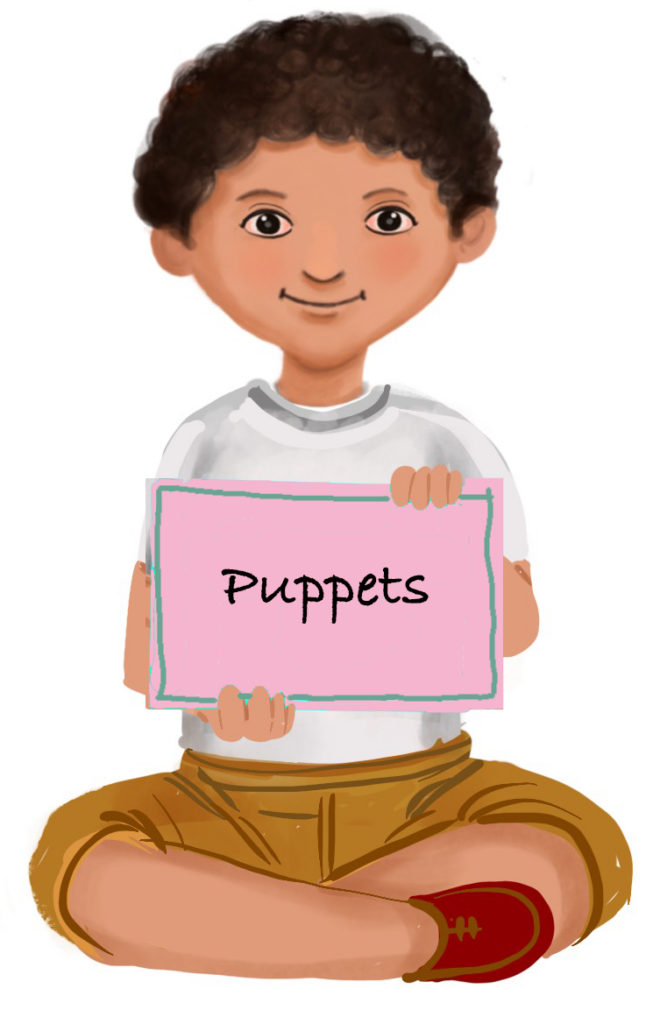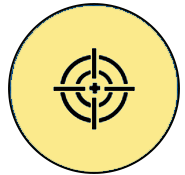
Bird – using Ball
 Objective
Objective
To help teachers in creating a puppet of a Bird for story-telling and other educational purposes.
Estimated time to create the Bird Puppet
30 to 45 Minutes
Materials required for creating the Bird Puppet
- Plastic ball – The colour of the ball can be chosen based on the type of bird (e.g., black for crow, green for a parrot). (In this demonstration, we are using a yellow ball)
- Coloured paper –Choose the paper colour to match the bird (e.g., grey for a crow, red for a parrot, brown for other birds etc.)
- White chart paper for making the finger pipe
- Googly eyes
- Pen knife
- Glue drops or Fevicol
- Scissors
Preparation for activity
Keep all materials ready in advance. If you are using hot glue instead of Fevicol, ensure it is suitably heated and ready for use.
Procedure
- For the finger pipe: Roll a small strip of paper into a tube that fits your forefinger (index finger) and glue it to secure the shape.
- Cut a circular hole in the plastic ball and fix the finger pipe into it
- For the beak: Take a piece of brown paper and cut out two triangular pieces—one slightly larger (A) than the other (B).
- Fold each triangular piece in half. Take piece A and make a small cut at the base of the triangle along the folded edge.
- Unfold the triangle and slightly fold the base edges inward up to the point where the cut was made. Repeat the same process for piece B.
- Apply glue to the folded edges of the larger triangle (A) and attach it to the plastic ball. This forms the upper part of the beak.
- Similarly, attach the smaller triangle (B) below it to form the lower part of the beak.
- For the eyes: Take two googly eyes, apply glue and fix them above the beak on either side of the ball. Ensure both eyes are placed on opposite sides of and equidistant from the beak.
- Allow the glue to dry for a few minutes. The puppet is now ready.
- Insert your forefinger (index finger) into the paper pipe.
- Move your finger up, down and sideways to demonstrate the movement of a bird’s head.
Step by Step Pictures to create the puppets

Important Tips
- Socks or gloves with stuffing can be used as a suitable alternative to a plastic ball for making the puppet.
- Instead of using googly eyes (plastic eyes which are available in the market), you can draw the eyes.
- Wedding cards or book covers can be good alternatives to drawing sheets.
- Reference images from drawing books or the internet can be helpful while designing the puppet.
- While creating the puppet, try to replicate the character illustration from the children’s textbook. Once the puppet is ready, refer to it by the character’s name from the textbook. This helps children connect with the content and improves recall.
- The teacher should use the puppet at an appropriate time, perhaps while narrating the story in a funny and humorous way. Intentional mistakes can also be made to encourage children to correct them, making the session more interactive and engaging.
Precautions
Precautions to be taken while manipulating finger puppets:
- Always keep the puppet’s face directed towards the audience.
- The Puppet Master’s focus should remain on the puppet at all times.
- Only the puppet that is ‘speaking’ should be animated; all other puppets should remain still.
Troubleshooting:
- While making the paper pipe, ensure it matches the exact size of the finger you will be using. This helps to move the puppet properly.
- Use a cutter carefully to make clean, precise holes.
- The holes should match the size of your fingers. If the hole is too large, the puppet won’t stay upright on your finger. If the hole is too small, it will be difficult to insert your finger.
 Notes to the Teacher
Notes to the Teacher
Puppets can be effectively used in the classroom to help children understand and express emotions. They are also valuable tools for teaching rhymes, songs, stories and more.
In addition to enriching learning experiences, using puppets supports the development of motor skills such as hand-eye coordination. They also enhance communication and social skills, improve focus and concentration, and help reinforce concepts and values in an engaging way.
Using the Learning Teaching Material
The teacher can demonstrate a puppet show as an example. Students can then be encouraged to create their own puppets and present a puppet show in the classroom.
Video: How to use Learning Teaching Material
| Source and Attribution of images All images used in the above Assets and Aids are originally created. |
| This digital material has been developed by the Sri Sathya Sai Vidya Vahini Inclusive Education Project, a unit of Sri Sathya Sai Central Trust, Prasanthi Nilayam, as a collaborative offering in the service of our nation. |